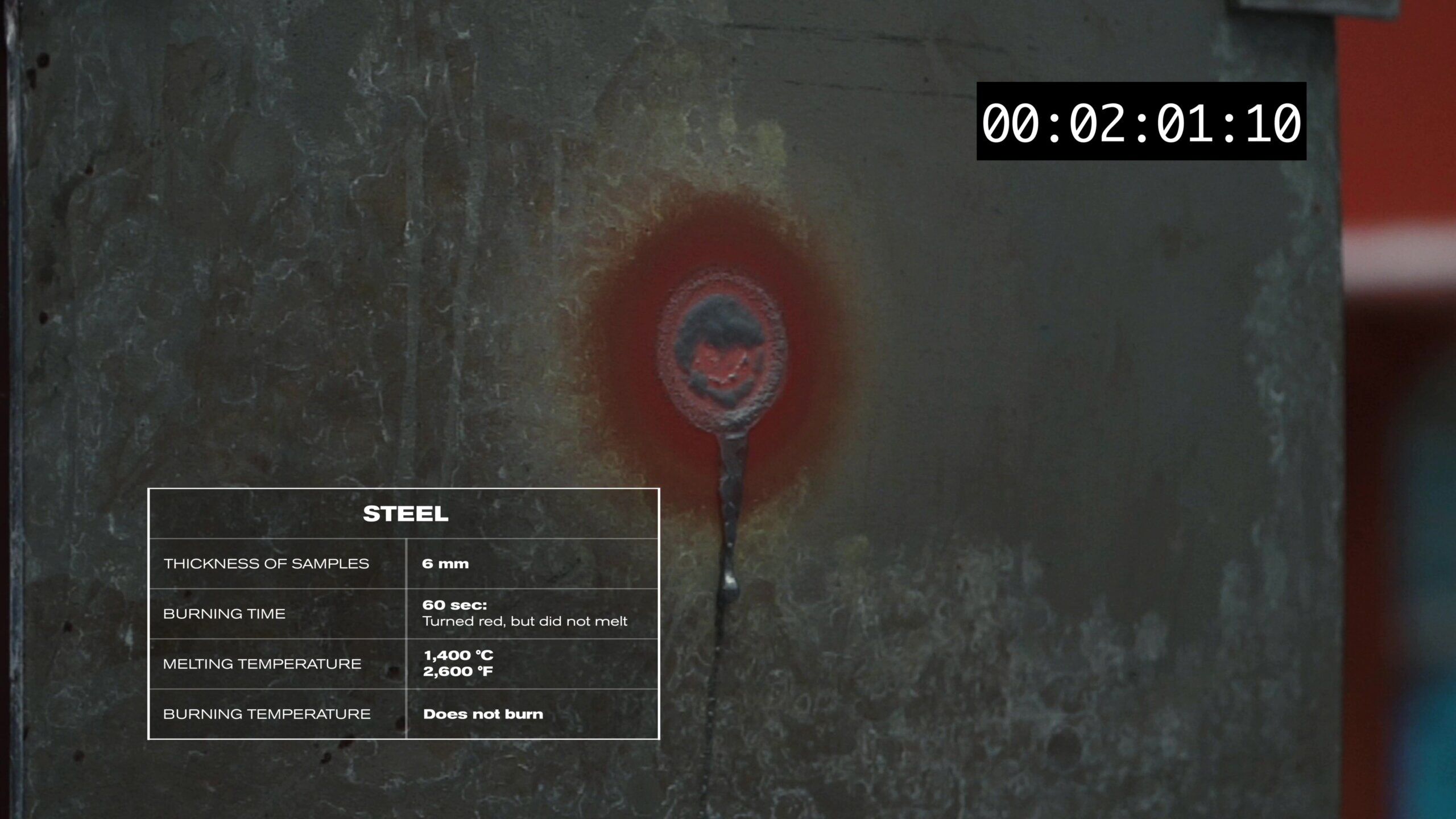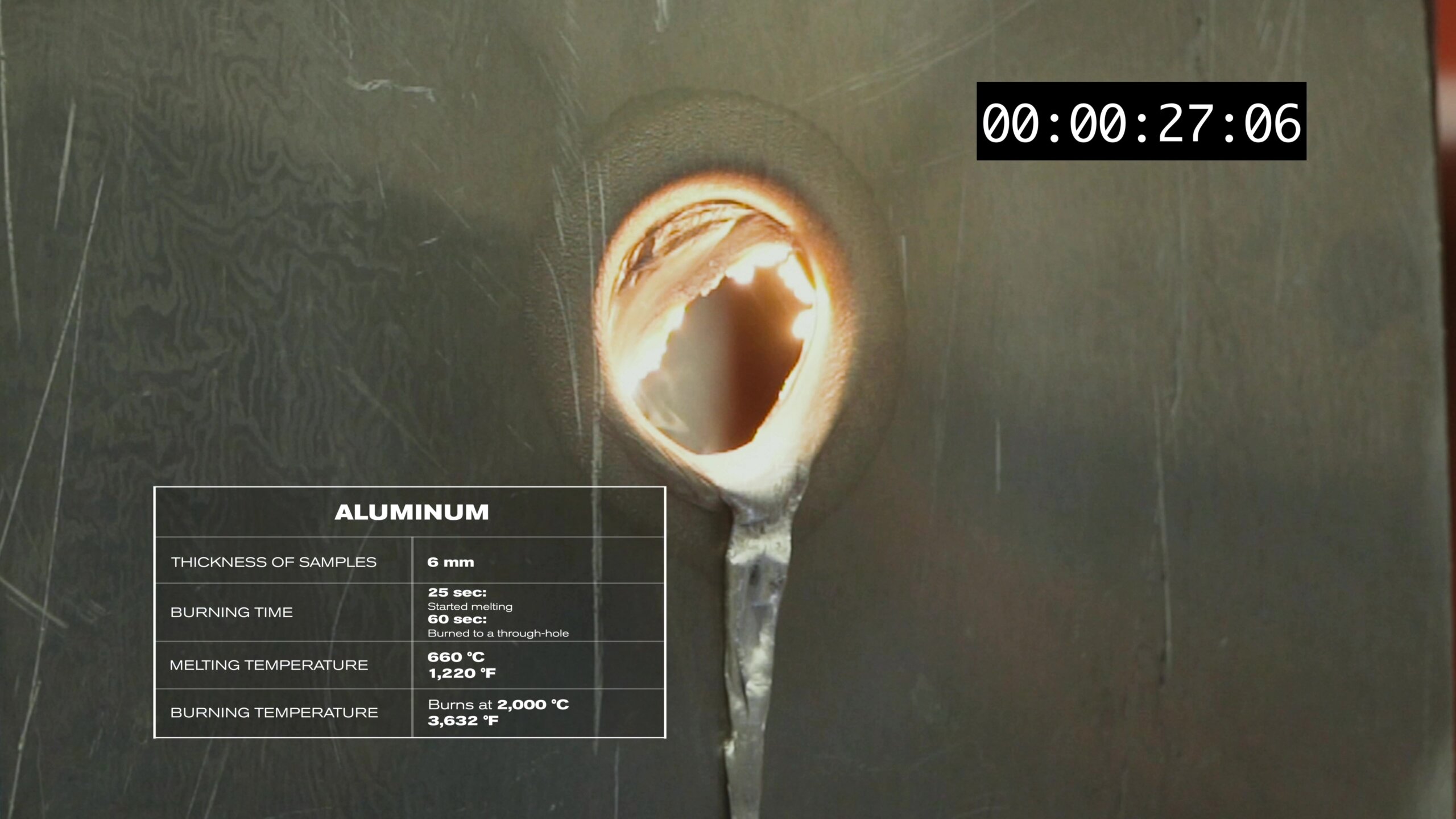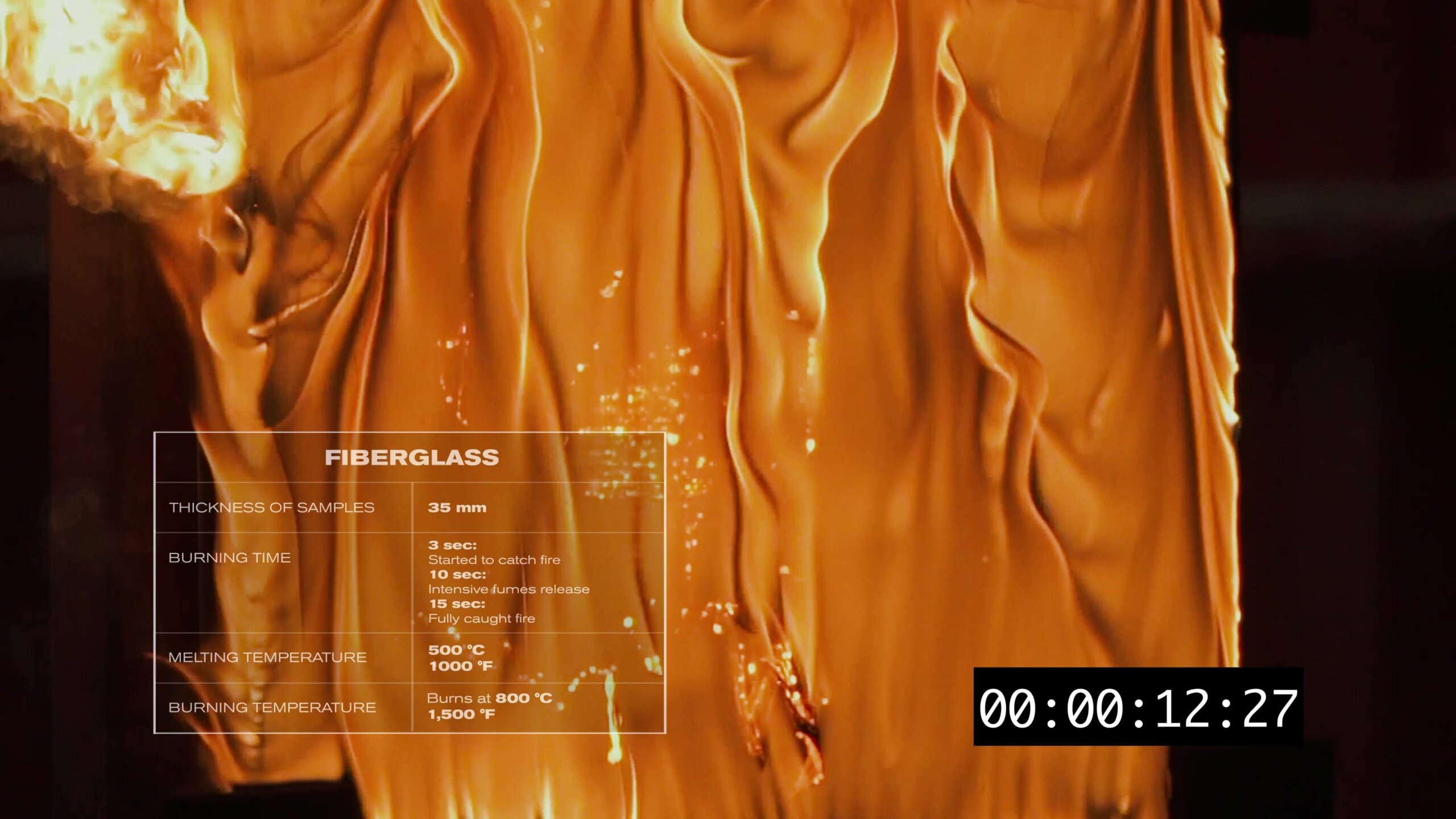Bering strongly believes that steel offers the best safety, durability, and comfort during a sea trip in yachts and in superyachts alike. But we wanted to put our belief to the test. In order to verify our hypothesis, we used three major criteria to determine what makes the best boat building material: impact protection, abrasion resistance, and fire safety. A series of semi-scientific experiments were conducted to this end.
Impact Protection: An Experiment
Each and every boat, expedition or leisure, displacement or planing, at some time during its lifespan, will have to withstand an impact of some sort. Be it an unexpected shoring, a collision with another sea object, running aground, or unlucky docking – a boat’s hull will be tested and, to continue operating normally, will have to tolerate the collision without a loss to structural integrity. Ideally, if such an event occurs, there should not even be a scratch that would require repairs or attention. The goal of this experiment was to determine the amount of impact each material can withstand while keeping passengers maximally safe.
In 2022, Bering Yachts funded a set of studies of static and dynamic impact resistance for steel and aluminum used at their shipyards. Fiberglass was not a part of this experiment. The materials used consisted of metal plates with the following characteristics:
- Marine-grade steel (35×35 centimeters plate of AH-36 grade steel, 6 and 8 millimeters thick)
- Aluminum (35×35 centimeters plate of 5083-type aluminum, 6 and 8 millimeters thick)
The study was performed by NPO Nauka PJSC. This company specializes in the development, manufacturing, testing, service and repair of aero-space systems, such as air conditioning, regulation of air pressure in flying vehicle cabins, cooling, life-support services and aggregates. The laboratory experiments involved performing impact and vibration testing to determine boat building materials’ resistance and toughness for different types of impact.
Experiment 1 – Repeated impact
The samples were exposed to multiple continuous hits with the acceleration of 15g; with the half-sine shaped pulse with duration of 11 microsecond. Pulse shape, acceleration and duration fall within the normal limits for the marine use impact testing. All the steel and aluminum samples showed no signs of destruction or deformation, which proves high resistance of metal materials to impact.
Experiment 2 – Vibration
The samples were exposed to sinusoidal and broad-band random vibration for periods of 30 minutes to 1 hour. Sinusoidal (fixed resonating frequency with the acceleration of 2g) and broad-band random (within the frequency range between 10 and 2,000 Hz and acceleration spectral density of 0,05 g2/Hz) vibration did not have any impact on the materials.
Experiment 3 – Stretching test
Using a universal testing machine, the samples were stretched to define the conditions for the critical deformation of both materials. The results yielded an interesting discovery. Specifically, the fracture strength of steel is more than 20% higher than aluminum, which indicates steel’s higher resistance to static pressure during the exploitation period. At the same time, steel’s formidable coefficient of elongation attests to the material’s high plasticity.
These results allow us to conclude that, as a shipbuilding material, steel provides more durability and resistance to wear and tear than aluminum. It is safe to assume that with a one-time or prolonged impact of similar force, the steel yacht and superyacht hull will sustain less damage thus providing higher safety to its passengers.
Abrasion Resistance: An Experiment
A boat hull must be resistant to abrasion because constant contact with the elements and objects are inevitable at sea. Water, small pebbles, moorings, and sand all scratch the hull. Abrasion both thins protective layers of the yacht paint and/or the material itself. Faster abrasion of the material means decreasing safety and growing maintenance/repair costs.
Abrasion resistance experiment took place in 2022, and has been performed by NPO Nauka PJSC. Using Taber abraser, researchers have conducted a 30-minute exposure of a coarse-grain abrasive paper with the pressure of 1.5 kilogram on the next samples provided by Bering Yachts:

Material thickness was measured before and after the experiment. The findings were as follows:
- Steel: 40 – 50 micrometer thickness loss in the abrasion area.
- Aluminum: 40 – 50 micrometer thickness loss in the abrasion area.
- Fiberglass: 250 – 500 micrometer thickness loss in the abrasion area.
Based on these results, steel and aluminum have similar resistance to abrasion while fiberglass has significantly lower results. This means that in extreme conditions steel and aluminum have a greater sturdiness than fiberglass, and less damage will be done to the yacht’s hull by the abrasive effect of external objects. What is important to note, the experimenters suspect that with longer test time and increased pressure the results for aluminum will yield results worse than steel, but this is a hypothesis that will have to be tested in the future.
Fire Safety: Two Experiments
With an ocean of water around you, there are not many things worse than the fire on the boat. With miles of cables and ventilation shafts, wood, and other potentially flammable materials on the inside, a yacht or superyacht hull that is not fire-resistant can vastly exacerbate the danger posed to the boat and everyone on board. Open sources provide the next information on the materials:
- Steel melts at about 1,400 degrees Celsius or 2,600 degrees Fahrenheit; it is very fire-resistant. Fire spreads slower on a steel vessel, giving more time for the crew to interfere or to leave the boat safely. There is also less hull deformation after the fire.
- Aluminum can melt and then burn. It melts at approximately 660 degrees Celsius or 1,220 degrees Fahrenheit, and starts burning if the heat goes higher. With a fire onboard, the vessel’s buoyancy can be compromised quicker, and there will be more resources and effort needed to restore the boat after the fire.
- Fiberglass – is fire resistant and non-flammable; however, it is not highly tolerant to heat. It melts at about 1, 000 degrees Fahrenheit or 500 degrees Celsius, and starts to burn at 1,500 degrees Fahrenheit or 800 degrees Celsius. The biggest danger in fiberglass exposure to high heat is that it can release very toxic fumes. Within minutes the boat fills with the black smoke that prevents breathing, causes cough, and restricts vision. It is a very dangerous material to be around during the fire.
Experiment 1 – In-home Fire Trial
Driven by curiosity, the Bering team decided to run a makeshift experiment using the same sample materials, steel. aluminum, and fiberglass, and an acetylene torch. Recorded on video, the samples yielded the next results:
Marine-grade steel (35×35 centimeters plate of AH-36 grade steel, 6 millimeters thick) started melting after almost 60 seconds of the high-temperature exposure (5,400 degrees Fahrenheit against about 2,000 degrees Fahrenheit for a regular fire). Steel sample did not melt through after a prolonged exposure to the torch.

Aluminum (35×35 centimeters plate of 5083-type aluminum, 6 millimeters thick) started melting about 25 seconds into the experiment, and burned through while forming a hole.

Fiberglass (35×35 centimeters sandwich panel of Vinyl-ester E-glass fiberglass, 30 millimeters thick) started to catch fire almost immediately, intensive fumes release began after 10 seconds of the exposure, and after 15 seconds it fully caught fire while continuing to release black smoke.

Experiment 2 – Burning Air
The NPO Nauka PJSC hot air experiment took place in 2022 and consisted of two parts. For the first thirty minutes all three samples were exposed to hot air with the temperature gradually changing from 20 to 600 degrees Celsius (68 to 1,112 Fahrenheit). For the second thirty-minutes period the hot air directed at samples was constantly at 600 Celsius (1,112 Fahrenheit).
Visual review of the samples after two types of exposure demonstrated that steel and aluminum pieces were not visually affected. For the fiberglass, there were obvious signs of vitrification of the exterior layer.
Therefore, the study of the fire safety of these three materials exposed fiberglass’ susceptibility to fire and hot air. Aluminum, to a certain degree, has better resistance than fiberglass; at least it does not emit toxic fumes while exposed to the fire. However, to affect steel and especially to melt through it, a significantly higher temperature has to be applied. In simple terms, aluminum is somewhat, and steel is way safer in regard to fire than fiberglass.
We build our yachts and superyachts from steel for exactly these reasons. Naturally, we also like fast, light, and pretty boats. They have their place. However, this is not our primary driving force. We could not bear if our boats would lose stability, safety, and displacement. Bering loves our boats and our clients too much to do otherwise. We enjoy when our customers feel at home – at a pool, at a gym, at a restaurant, at a cocktail party, at a luxurious hotel, at a sauna, at a marina, at an airport, and so on – all while riding the sea in a Bering yacht. There was no other choice but to use and to continue to use steel, for the peace of mind for us and for our customers.
This is chapter two of Bering: Made of Steel article. Follow the updates for the release of the next chapter.
REFERENCES/MATERIALS
1. Octal Metals. AH36, DH36, EH36 Steel Plate for Shipbuilding // 2021.
URL: https://www.octalmetals.com/ah36-dh36-eh36-shipbuilding-steel-plate/ (accessed on 15.06.2022)..
2. Yanxia L., Bing W., Yanjun M., Ming C., Zhongqi D. Study on the process control of AH36 high strength ship plate // IOP Conf. Series: Materials Science and Engineering. 2017. DOI:10.1088/1757-899X/207/1/012049.
3. Djukanovic G. Aluminium alloys in shipbuilding – a fast growing trend // 2016.
URL: https://aluminiuminsider.com/aluminium-alloys-in-shipbuilding-a-fast-growing-trend/ (accessed on 13.06.2022).
4. Ertuğ B., Kumruoğlu L.C. 5083 type Al-Mg and 6082 type Al-Mg-Si alloys for ship building // American Journal of Engineering Research. 2015. Vol. 4. No. 3. 146—150.